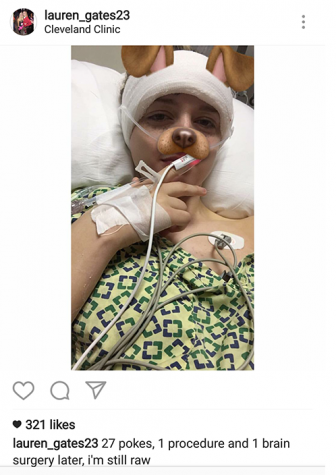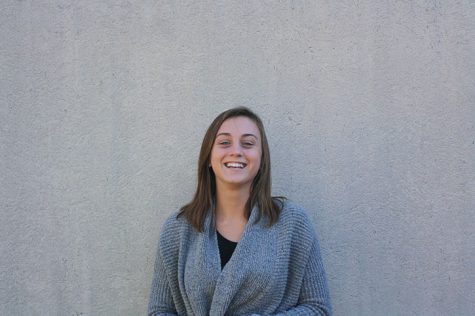SHS Alumni undergoes brain surgery
Lauren Gates diagnosed with cavernoma

 What began as a simple trip to the nurse for relief from her migraines ended with SHS alumna Lauren Gates in the emergency room.
What began as a simple trip to the nurse for relief from her migraines ended with SHS alumna Lauren Gates in the emergency room.
Gates said she had reported her migraines three times to the nurses at Bowling Green State University, but none of their treatments worked. When Gates’ father decided to take
action and took her to the hospital for a CT scan, they learned Gates had a brain tumor.
“They did the CT
scan…pulled my dad out of the room, and told him something,” Gates recalled. “He came back crying and it scared me because they didn’t tell me anything yet.”
Gates was immediately life-flighted to St. Vincent’s Hospital in Cleveland, where she was told she needed surgery within the next 24-48 hours. She was life-flighted again to the Cleveland Clinic, where she underwent MRIs and CT scans to confirm the diagnosis.
Surgery, however, was delayed after it became apparent that the headache medicine she received from the BGSU nurse had thinned her blood. Thinned blood would cause massive bleeding during the operation, so it was declared too risky to remove the tumor at the time.

Gates had to wait a week for the medicine to exit her system so the doctors could operate on the brain tumor.
In the midst of the five-hour surgery to remove the golf-ball sized tumor, the doctors discovered it was a cavernoma, an abnormal cluster of blood cells in the brain. The surgery was considered successful, and Gates walked away with a titanium plate and a seven-inch long scar in her head, to remember it by.
Cavernomas typically cause seizures, hemorrhages, stroke-like symptoms and headaches. Gates was fortunate enough to only experience migraines and a loss of balance caused by the cavernoma on the cerebellum, which located where the spinal cord meets the brain.
The cavernoma was confirmed as noncancerous, and Gates is unlikely to go through this again, since it can not spread anywhere else.

She will be able to return to school in January, with only two more follow-up appointments December and a yearly MRI until 2019.
She can even report back to work within the next two weeks.
Gates was left exhausted from the surgery, and was told it will take another six weeks for her to gain the energy back.
Senior Megan Curran is close friends with Gates and visited her in the hospital after the diagnosis.
“My biggest frustration was just getting to see my best friend,” Curran said. “She’s so young and I wouldn’t wish anything like that upon anyone. She’s a strong girl…I know deep down she wanted to cry. I was crying since I found out the news…I wanted to be there for her as much as I could….I’m just happy and thankful that she’s in my life.”
For more info on cavernomas check out https://www.cavernoma.org.uk/about-cavernoma/
Your donation will support the student journalists of Streetsboro High School. Your contribution will allow us to purchase equipment and cover our annual website hosting costs.






